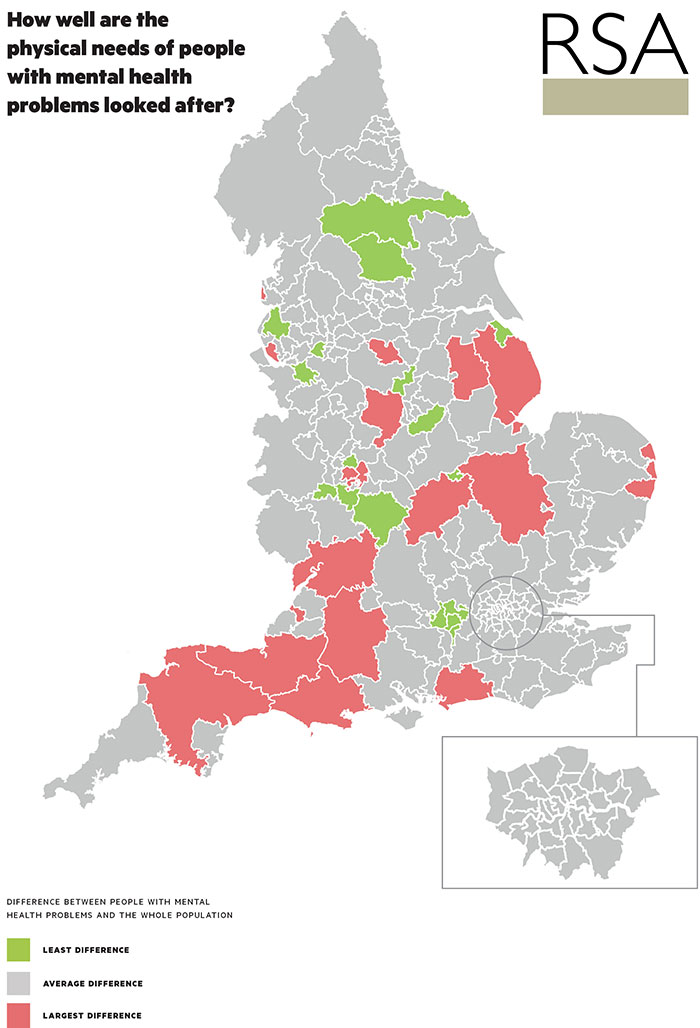Recently I saw a Facebook post of a woman who had been denied a credit card by her bank. Having declared a mental health condition, which she was successfully managing, the bank had at first increased the liable annual interest rate, and then questioned the suitability of her holding a credit card at all.
It seems that the gap between people living with or without mental health conditions extends beyond the likelihood of premature mortality. It is quietly endemic across a range of life experiences.
The Open Public Services Network (OPSN), based at the RSA, has been exploring some of these differences using publically available health and local authority data. Guided by an expert panel of mental health care information professionals and clinicians, OPSN has drawn together a number of disparate datasets that, whilst publically available, are only accessible if and where people know where to look.
Public sector transparency hinges on appropriate communication of data, not just releasing a complex dataset in an unknown corner of a website. It is the communication of data to the public that OPSN is concerned with, and this is the third of our major projects designed to improve access to comparative data in public services. In this way, we transform data from being a closed shop business, to a truly open means of shifting power to people and communities – informing service users of the facts, supporting them in their dialogue with providers, prompting wider public debate and holding to account commissioners, regulators and policy makers.
Funded by the Cabinet Office Data Release Fund, OPSN has created four new, composite indicators (with the datasets available for download under open license here). These indicators are designed to enable people, particularly patients, to answer four important questions:
- How well is my GP looking after my physical health needs?
- What is the likelihood of getting access to the right psychological therapies, and what is the impact if I don’t?
- Am I more or less likely than average to be prescribed anti-depressants?
- How well am I helped to live well with my condition?
We know that people with mental health conditions are more likely to die prematurely (before 75 years old). What’s new in the data we publish today is the extent to which this, and similar trends of excess mortality for people living with mental health issues, is underpinned by GPs failing to look after their physical health needs (question 1).
The map below illustrates shows that large areas of the South West, for example, experience the greater difference in the rates of referral for physical tests, including high cholesterol and diabetes. Leaving these often-treatable long-term physical conditions undiagnosed is a key risk factor in the overall health of local people. In our accompanying report, ‘Getting the Message on Mental Health’, we call for Public Health England, the Local Government Association and public heath leaders urgently to agree a systematic review of strategies to improve the physical as well as mental health care of people with mental ill health, and especially those with the most serious of conditions.
Maps of our other three composite indicators (see above) can be found here, illustrating the fact that in Sandwell, for example, people with serious mental health conditions are 50% less likely to be employed than the total population. In Surrey Heath, only 3.25% of the population with anxiety and depression have, in any one calendar month, access to the Improving Access to Psychological Therapies programme (IAPT). Croydon CCG does little better, with 4.33% accessing talking therapy treatment.
But if these variations were troubling enough, what’s clear in each of the illustrations above is the extent to which there are data deserts - where Clinical Commissioning Groups or Local Authorities are failing to collect sufficient or comparable aggregate (anonymised) information.
Lack of data is arguably the biggest indictment of our mental health system. Whilst there is a national minimum dataset and the Improving Access to Psychological Therapies (IAPT) programme reports its own access and outcomes data, what is available is mostly focused on secondary care hospital and community services. There is very little information on primary care services, where 80-90% of all those with mental ill health present for treatment. The Quality and Outcomes Framework for GPs (QoF) has removed several indicators for cardiovascular and diabetes checks in patients with severe mental illness for 2014/15, the seriousness of which is articulated by Dr David Shiers during our research: “This is of considerable concern given that people with severe mental illness die on average 15-20 years earlier than the general population, mainly from potentially preventable physical disorders. For example, the prevalence of type 2 diabetes is 2-3 fold higher compared with the general population, and rates of undiagnosed diabetes are up to 70%.”
All this begs the question, how can we aspire for parity of esteem between mental and physical health if we cannot sufficiently understand the needs of local people or the degree to which our current configuration of services meets them? When up to one in four people will experience mental health problems in their lives at one point, we can’t continue to brush it under the proverbial carpet in primary care and hope that it is enough for other aspects of the health system to capture the complex causes and consequences of mental health.
Try our interactive tool: Living a Long Life? How mental health impacts life expectancy
Data: Download our data & methodology
Find out more about the OPSN Mental Health project


Join the discussion
Comments
Please login to post a comment or reply
Don't have an account? Click here to register.
Depressing. I suppose that means I'll have a heart attack and die. Or maybe not. Just because you show me nice charts and maps doesn't mean what you say is true. Magical thinking is so difficult to eradicate, and now here's the RSA promoting it. Anyway, I blogged about it myself and I'm not confident that your blog can process pingbacks, so here's the link: http://wp.me/p15Y7l-Hd